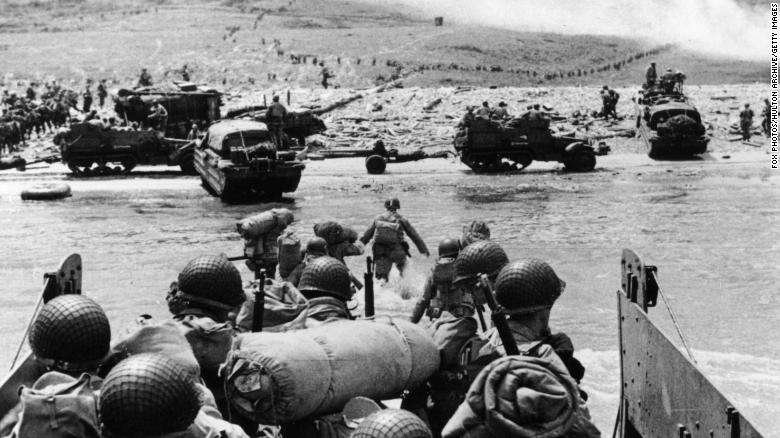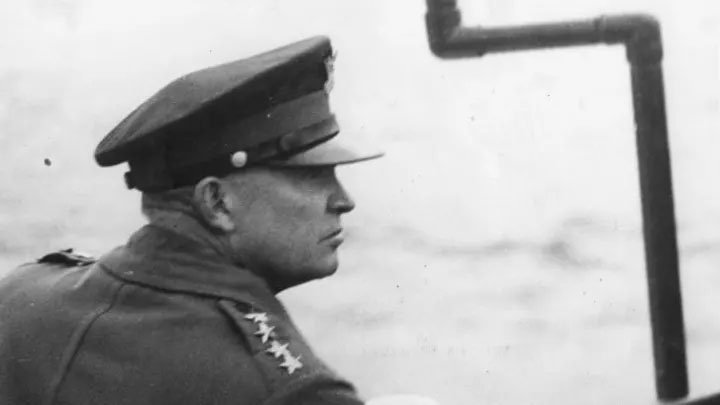Reflections on the Triumph of D-Day: Unveiling Fascinating Aspects of the Momentous WWII Operation
Today marks a significant milestone in the annals of history, as we commemorate the moment when the tides began to turn against the Nazis during World War II. On June 6, 1944, in what has come to be known as the Normandy landings or “D-Day,” thousands of brave men and women prepared to partake in an operation that would signal the beginning of the end of the war. With meticulous planning and the involvement of over 130,000 Allied troops, this audacious endeavour would forever etch its name in the annals of warfare.
The staggering scale of the D-Day landings is still unparalleled. By the day’s end, more than 10,000 individuals had made the ultimate sacrifice, been injured, or found themselves as prisoners of war. It remains the largest seaborne military operation in human history—a testament to the indomitable spirit of those involved.
The Normandy landings, with their codename “D-Day,” stand as an iconic turning point in the Second World War. A crucible of strategic manoeuvring, intense losses, and the employment of innovative tactics such as semiaquatic tanks, this audacious amphibious invasion secured its place as a defining moment in human history. Today, we embark on a journey to unearth captivating facets of this historic crusade, as we delve into the relentless quest to liberate France from the clutches of Nazi Germany.
As we honour the valour of the men and women who participated in this epochal campaign, let us uncover a few intriguing aspects that shed light on the magnitude of their achievements. From the intricate planning to the art of deception, from the battles fought on land, air, and sea to the heroism displayed on those fateful shores, D-Day encapsulates the very essence of courage, sacrifice, and survival in the face of unimaginable odds.
D-Day was an awe-inspiring testament to the resilience of the human spirit. Through the corridors of time, the legends of this pivotal moment in history continue to resonate, reminding us of the remarkable feats that can be achieved when humanity unites against tyranny.
We cannot add much to the celebrations of the Normandy landings but we hope to give you some interesting facts.
OPERATION OVERLORD
Operation OVERLORD, the invasion of Normandy, France, on 6 June 1944, was the Western Allies’ greatest operation of World War II and the finest hour of Anglo-American cooperation. Only the United States and the British Empire could have successfully undertaken the largest and most dangerous amphibious assault in history. The operation was so complicated that U.S. Army Chief of Staff General George C. Marshall said it “almost defies description.” The Allies assembled 2 million troops of numerous nationalities, nearly 5,000 ships, and 11,000 aircraft without the Germans knowing where or when the invasion would take place.
D-DAY OCCURRED ON JUNE 6, 1944.
The D-Day invasion was several years in the making. In December 1941, the United States formally entered World War II. Shortly thereafter, British and American strategists began entertaining the possibility of a huge offensive across the English Channel and into Nazi-occupied France. But first, the Allies swept through northern Africa and southern Italy, weakening the Axis hold on the Mediterranean Sea. Their strategy resulted in Italy’s unconditional surrender in September 1943 (though that wasn’t the end of the war in Italy). Earlier that year, the Western allies started making preparations for a campaign that would finally open up a new front in north-western France. It was going to be an amphibious assault, with tens of thousands of men leaving England and then landing on France’s Atlantic coastline.
NORMANDY WAS CHOSEN AS THE D-DAY LANDING SITE BECAUSE THE ALLIES WERE HOPING TO SURPRISE GERMAN FORCES.
Since the Germans would presumably expect an attack on the Pas de Calais—the closest point to the UK—the Allies decided to hit the beaches of Normandy instead. Normandy was also within flying distance of warplanes stationed in England, and it had a conveniently located port.
D-DAY ACTION CENTERED AROUND FIVE BEACHES THAT WERE CODE-NAMED “UTAH,” “OMAHA,” “GOLD,” “JUNO,” AND “SWORD.”

Altogether, the D-Day landing beaches encompassed 50 miles of coastline real estate [PDF]. The Canadian 3rd Division landed on Juno; British forces touched down on Gold and Sword; and the Americans were sent to Utah and Omaha. Of the five beaches, Omaha had the most bloodshed: Roughly 2400 American casualties—plus 1200 German casualties—occurred there. How the beaches got their code names is a mystery, although it’s been claimed that American general Omar Bradley named “Omaha” and “Utah” after two of his staff carpenters. (One of the men came from Omaha, Nebraska, while the other called Provo, Utah, home.)
PULLING OFF THE D-DAY LANDINGS INVOLVED SOME ELABORATE TRICKERY TO FOOL THE NAZIS.
If the Allies landed in France, Hitler was confident that his men could repel them. “They will get the thrashing of their lives,” the Führer boasted. But in order to do that, the German military would need to know exactly where the Allied troops planned to begin their invasion. So in 1943, the Allies kicked off an ingenious misinformation campaign. Using everything from phoney radio transmissions to inflatable tanks, they successfully convinced the Germans that the British and American forces planned to make landfall at the Pas de Calais. Duped by the charade, the Germans kept a large percentage of their troops stationed there (and in Norway, which was the rumoured target of another bogus attack). That left Normandy relatively under-defended when D-Day came along.
D-DAY WAS PLANNED WITH THE HELP OF METEOROLOGISTS.
The landings at Normandy and subsequent invasion of France were code-named “Operation Overlord,” and General Dwight D. Eisenhower (the future U.S. president) led the operation. To choose the right date for his invasion, Eisenhower consulted with three different teams of meteorologists, who predicted that in early June, the weather would be best on June 5, 6, or 7; if not then, they’d have to wait for late June.
Originally, Eisenhower wanted to start the operation on June 5. But the weather didn’t cooperate. To quote geophysicist Walter Munk, “On [that date], there were very high winds, and Eisenhower made the decision to wait 24 hours. However, 24 hours later, the Americans predicted there would be a break in the storm and that conditions would be difficult, but not impossible.” Ultimately, Ike began the attack on June 6, even though the weather was less than ideal. It’s worth noting that if he’d waited for a clearer day, the Germans might have been better prepared for his advance. (As for the dates they’d suggested for late June? There was a massive storm.)
“D-DAY” WAS A COMMON MILITARY TERM, ACCORDING TO EISENHOWER’S PERSONAL AIDE.
A few years after Eisenhower retired from public life, he was asked if the “D” in “D-day” stood for anything. In response to this inquiry, his aide Robert Schultz (a brigadier general) said that “any amphibious operation has a ‘departed date’; therefore the shortened term ‘D-Day’ is used” [PDF]
D-DAY WAS AMONG THE LARGEST AMPHIBIOUS ASSAULTS IN MILITARY HISTORY.

On D-Day, approximately 156,115 Allied troops—representing the United States, the United Kingdom, Canada, Australia, Belgium, Czechoslovakia, France, Greece, New Zealand, Norway, and Poland—landed on the beaches of Normandy. They were accompanied by almost 7000 nautical vessels. In terms of aerial support, the Allies showed up with more than 10,000 individual aircraft, which outnumbered the German planes 30 to one.
ON D-DAY, FLOATING TANKS WERE DEPLOYED BY THE ALLIES.
The brainchild of British engineers, the Sherman Duplex Drive Tanks (a.k.a. “Donald Duck” tanks) came with foldable canvas screens that could be unfurled at will, turning the vehicle into a crude boat. Once afloat, the tanks were driven forward with a set of propellers. They had a top nautical speed of just under 5 mph. The Duplex Drives that were sent to Juno, Sword, and Gold fared a lot better than those assigned to Omaha or Utah. The one at Omaha mostly sank because they had to travel across larger stretches of water—and they encountered choppier waves.
WHEN THE D-DAY ATTACK STARTED, ADOLF HITLER WAS ASLEEP.
On the eve of D-Day, Hitler was entertaining Joseph Goebbels and some other guests at his home in the Alps. The dictator didn’t go to bed until 3 a.m. Just three and a half hours later, at 6:30 a.m., the opening land invasions at Normandy began. (And by that point, Allied gliders and paratroopers had been touching down nearby since 12:16 in the morning.) Hitler was finally roused at noon, when his arms minister informed him about the massive assault underway in Normandy. Hitler didn’t take it seriously and was slow to authorize a top general’s request for reinforcements. That mistake proved critical.
EISENHOWER WAS FULLY PREPARED TO ACCEPT BLAME IF THINGS WENT BADLY ON D-DAY.

While Hitler was partying in the Alps, Eisenhower was drafting a bleak message. The success of Operation Overlord was by no means guaranteed, and if something went horribly awry, Ike might have had no choice but to order a full retreat. So he preemptively wrote a brief statement that he intended to release if the invasion fell apart. “Our landings in the Cherbourg-Havre area have failed to gain a satisfactory foothold and I have withdrawn the troops,” it said. “My decision to attack at this time and place was based upon the best information available. The troops, the air and the Navy did all that bravery and devotion to duty could do. If any blame or fault attaches to the attempt it is mine alone.”
KNOCKING OUT GERMAN COMMUNICATIONS WAS ONE OF THE KEYS TO VICTORY ON D-DAY.
Hitler may not have had all of his troops in the right spot, but the Germans who’d been stationed at Normandy did enjoy some crucial advantages. At many localities—Omaha Beach included—the Nazi forces had high-powered machine guns and fortified positions. That combination enabled them to mow down huge numbers of Allied troops. But before the dawn broke on June 6, British and American paratroopers had landed behind enemy lines and taken out vital lines of communication while capturing some important bridges. Ultimately, that helped turn the tide against Germany.
THEODORE ROOSEVELT‘S SON EARNED A MEDAL OF HONOR FOR FIGHTING ON D-DAY.
It was the 56-year-old brigadier general Theodore Roosevelt Jr. who led the first wave of troops on Utah Beach. The men, who had been pushed off-course by the turbulent waters, missed their original destination by over 2000 yards. Undaunted, Roosevelt announced, “We’re going to start the war from right here.” Though he was arthritic and walked with a cane, Roosevelt insisted on putting himself right in the heart of the action. Under his leadership, the beach was taken in short order. Roosevelt, who died of natural causes one month later, was posthumously awarded the Medal of Honor.
D-DAY WAS THE OPENING CHAPTER IN A LONG CAMPAIGN.
The Normandy invasion was not a one-day affair; it raged on until Allied forces crossed the River Seine in August [PDF]. Altogether, the Allies took about 200,000 casualties over the course of the campaign—including 4413 deaths on D-Day alone. According to the D-Day Center, “No reliable figures exist for the German losses, but it is estimated that around 200,000 were killed or wounded with approximately 200,000 more taken prisoner.” On May 7, 1945—less than a year after D-Day—Germany surrendered, ending the war in its European Theater.
Support Independent Journalism Today
Our unwavering dedication is to provide you with unbiased news, diverse perspectives, and insightful opinions. We're on a mission to ensure that those in positions of power are held accountable for their actions, but we can't do it alone. Labour Heartlands is primarily funded by me, Paul Knaggs, and by the generous contributions of readers like you. Your donations keep us going and help us uphold the principles of independent journalism. Join us in our quest for truth, transparency, and accountability – donate today and be a part of our mission!
Like everyone else, we're facing challenges, and we need your help to stay online and continue providing crucial journalism. Every contribution, no matter how small, goes a long way in helping us thrive. By becoming one of our donors, you become a vital part of our mission to uncover the truth and uphold the values of democracy.
While we maintain our independence from political affiliations, we stand united against corruption, injustice, and the erosion of free speech, truth, and democracy. We believe in the power of accurate information in a democracy, and we consider facts non-negotiable.
Your support, no matter the amount, can make a significant impact. Together, we can make a difference and continue our journey toward a more informed and just society.
Thank you for supporting Labour Heartlands









